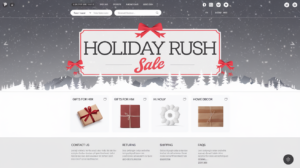According to Shopify, global e-commerce sales are expected to grow by 9.4% in 2024, reaching $6.3 trillion. To capitalize on this growth, it’s crucial to ensure your e-commerce site has the right features.
Why Do eCommerce Sites Need Good Features?
There are two essential things to keep in mind:
- A good e-commerce site architecture serves both humans and machines. This means that a well-structured site is easy for users to navigate and for search engines to index.
- A good site structure makes browsing intuitive. It anticipates users’ actions and helps them find what they’re looking for without much effort. Conversely, a poor site architecture is confusing and hard to use, both for visitors and search engines.
A well-organized site makes finding information straightforward and intuitive, which enhances the user experience. Additionally, such content is easily indexed by search engines, making it more accessible to users through search results.
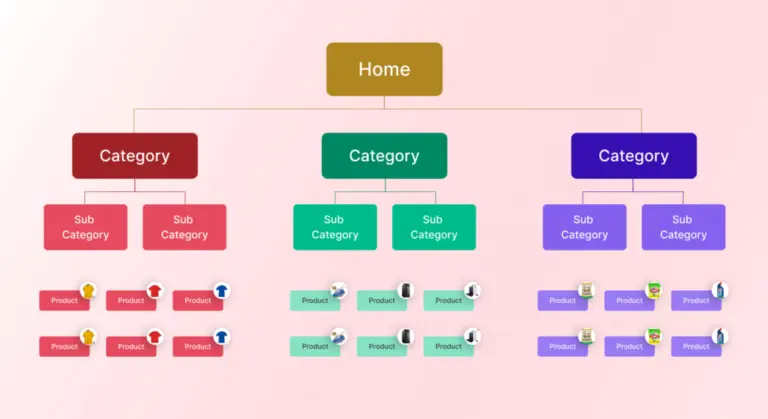
When building your e-commerce website, it’s easy to get caught up in aesthetics. However, a beautiful online store alone won’t guarantee sales. At 42Works, we believe in creating websites that are both functional and visually appealing.
What are the 11 Must-Have Features of E-commerce Websites?
Below we’ve listed 11 essential features you must implement on your eCommerce site to make your site stand out from the crowd.
#1: A Responsive Design for Every Device
In today’s mobile-first world, ensuring your website flawlessly adapts to any screen size is crucial. This is called responsiveness, and it’s a major ranking factor for search engines like Google. After all, studies show a whopping 58% of website traffic comes from mobile devices!
Imagine a potential customer browsing your store on their phone. If your website isn’t responsive, it might appear clunky, and difficult to navigate, and ultimately lead them to a competitor. Don’t miss out on these valuable mobile shoppers! A study about how many people prefer mobile phones to purchase online shows that,
61% of consumers are more likely to buy from mobile-friendly eCommerce websites.
The good news is that creating a responsive website isn’t complex. Many high-quality themes are available on popular e-commerce platforms like WooCommerce, Shopify, and Magento. These themes offer a user-friendly experience for both mobile and desktop users.
Consider partnering with an e-commerce development company for even greater control and customization. While this might involve an investment, it allows you to tailor your website to perfectly match your brand and vision.
#2: Design that Drives Sales
How effective is the design of your website? Are your web pages cluttered and unattractive?
No matter how great and powerful your e-commerce site is, it won’t achieve the expected conversions if the design is lacking.
Consider these two websites. Which one do you think will convert better?
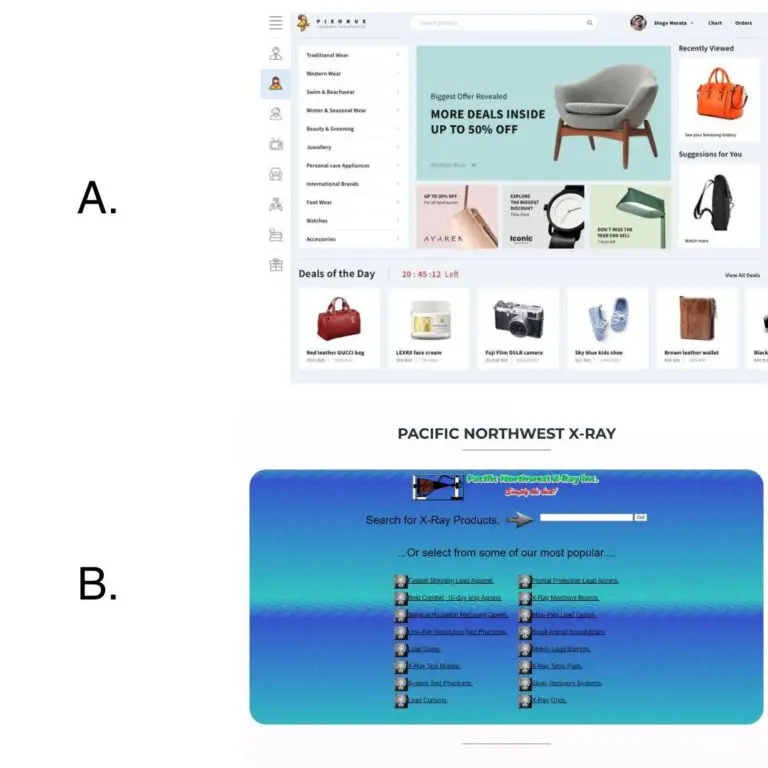
A, right?
While both are eCommerce websites, their user experiences are vastly different.
Site B suffers from a terrible mix of colors, a poor layout, and an odd choice of font. In contrast, Site A is visually appealing and user-friendly.
Notice that Site A uses just two colors and a very simple layout. This demonstrates that creating a great user experience doesn’t require complexity.
As you might have guessed, the key to making your website shine and stand out is using a quality website theme. You don’t need to write any code.
#3: Optimize Your Site for Fast Load Times
In today’s fast-paced world, website speed is crucial for e-commerce success. Studies show that visitors bounce from slow-loading websites (taking more than 2 seconds) and conversion rates plummet with each additional second of delay.
A slow website not only frustrates customers but also hurts your search engine ranking. Google prioritizes websites that deliver a speedy experience.
So, how can you ensure your e-commerce website loads like lightning?
- Image Optimization: Large, unoptimized images are a major culprit behind slow loading times. Invest in image optimization tools that can significantly reduce file size without sacrificing quality.
- Minimize Plugins: While plugins add functionality, they can also slow down your website. Use only essential plugins and keep them updated.
- Content Delivery Network (CDN): Consider using a CDN to store website content on geographically distributed servers. This ensures faster loading times for visitors in different locations.
- Browser Caching: Enable browser caching to store website elements on visitors’ devices. This reduces the need to download the same content repeatedly, improving subsequent visits.
By prioritizing website speed, you create a positive user experience, boost conversions, and improve your search engine ranking – all essential ingredients for e-commerce success.
| Have a project in mind? Let’s talk about it. CONTACT US NOW! |
#4: Provide Easy Navigation
If you are serious about scaling your e-commerce business, making your website easy to navigate is crucial. Visitors should be able to move through your pages effortlessly without any confusion.
If navigation is difficult, visitors may leave your site for good. One effective way to ensure easy navigation is by using a well-detailed navigation menu. Even better, implement a mega menu that includes links to all category and product pages on your site.
Additionally, make sure to include a detailed menu in your website footer. This will further enhance navigation and improve the user experience.
#5: Make Finding Products Easy
Customers are impatient! If they can’t quickly find what they’re looking for, they’ll abandon your site. The solution? A powerful search feature!
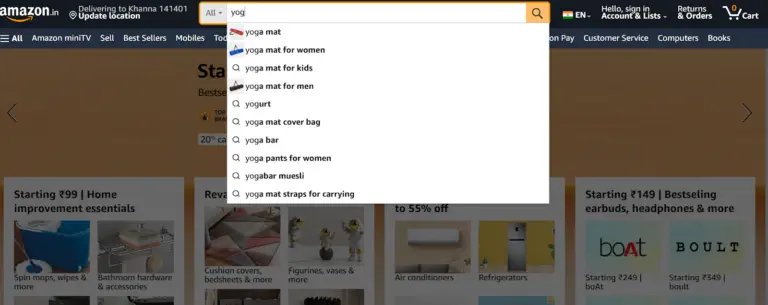
- Smart Search:Just like Google and Amazon, your search bar should offer intelligent suggestions as users type.
- Easy Access: Don’t hide your search bar! Make it visible on every single page of your website. A magnifying glass icon is a universal symbol for search and helps users identify it easily.
- Simplicity is Key: There’s no need for a complicated search bar. Keep it clean and user-friendly
By following these tips, you’ll create a frustration-free shopping experience that keeps customers happy and coming back for more!
#6: Sorting and Filtering
Sorting and filtering are crucial features for any successful eCommerce website.
Including these tools on your site allows customers to easily find specific products based on their budget and preferences.
Like the site search, sorting and filtering options should be highly visible and efficient. By efficient, we mean they should allow quick sorting and filtering of products.
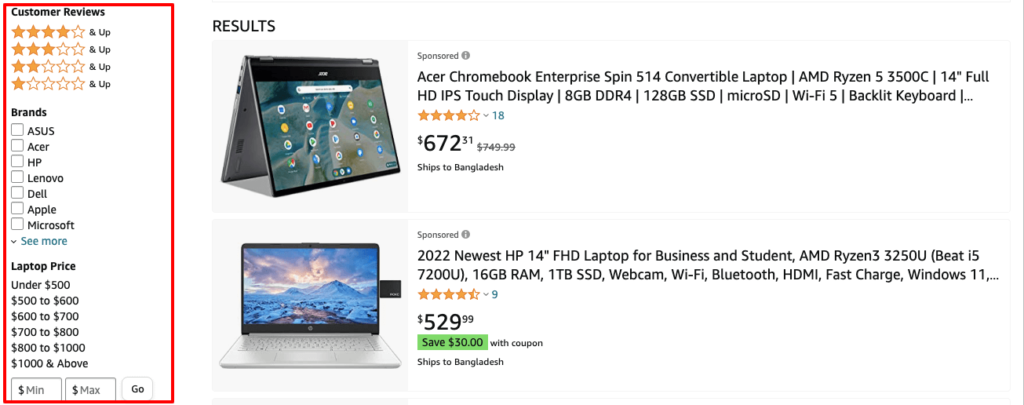
Initially, your sorting and filtering options should enable customers to find products based on:
- Price
- Color
- Size
- New/old
- Reviews and ratings
Of course, you can always add more filtering and sorting options as needed.
#7: Keep Multiple Payment Options
Restricting your customers to just one or two payment options can have serious consequences. Most notably, you risk losing many sales, especially if you have international customers.
Offering multiple payment options is crucial in e-commerce for several reasons:
Firstly, some payment options are not available in certain countries. For example, if you only accept PayPal, you’ll exclude customers from countries where PayPal isn’t available.
Secondly, many shoppers prefer to use their favored payment methods. If they can’t use their preferred option, they might leave your site and shop elsewhere.
Therefore, providing various payment methods makes sense to accommodate different preferences and regions.
#8: Guest Checkout
Have you noticed that many online stores don’t require an account to shop? This is because most now offer guest checkout.
Enabling guest checkout on your eCommerce site enhances the shopping experience by eliminating the need for account creation to make a purchase.
It also captures impulsive buyers and significantly reduces cart abandonment rates. Forcing shoppers to sign in at checkout can frustrate them, leading to abandoned carts.
#9: Clear Return Information
Product return information is essential for any e-commerce website.
Not all sales go smoothly, and customers may need to return products for various reasons, such as incorrect size, defective items, or simply changing their minds.
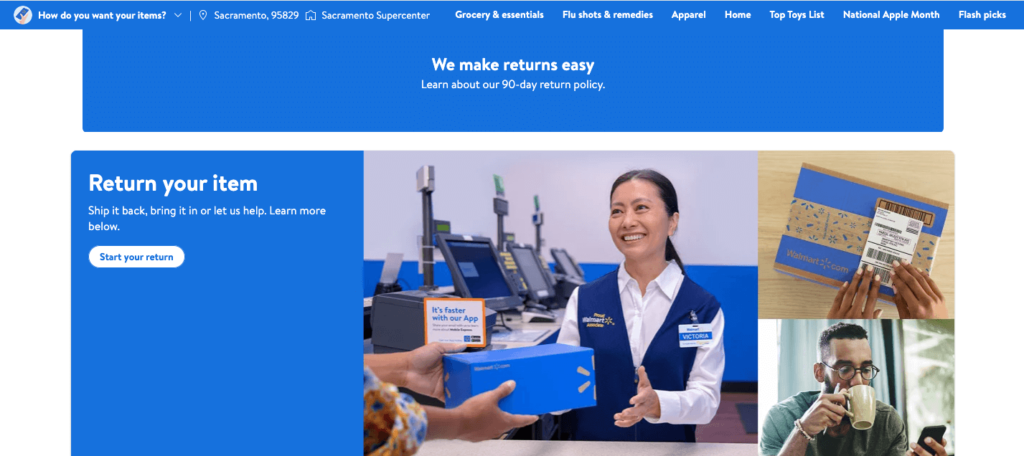
They need clear information on your return policy, including:
- Whether returns are free
- The minimum waiting period for returns
- If they can exchange a product for another
Answering these questions in your return policy helps build trust and ensures a smooth return process for customers.
#10: Comprehensive FAQ Page
While having product return information is important, it must be easy to find. An FAQ page is the perfect place for this.
An FAQ page is a must-have for every e-commerce website. It not only provides return policy details but also answers common customer questions, such as:
- Do you offer discounts on bulk purchases?
- What are your shipping times and offers?
Without an FAQ page, customers may leave if they can’t find answers, or they’ll flood your emails with questions.
Ensure your FAQ page is detailed and easy to navigate to enhance the customer experience.
#11: Live Chat Support
FAQ pages are helpful, but not everyone has the patience to read through them. Many customers prefer speaking with someone directly.
Support chat is an essential feature for your e-commerce site. It not only enhances the customer experience but also builds credibility for your business.
Conclusion
Congratulations! You’ve explored 11 essential features that can transform your online store into a sales powerhouse.
Ready to take your e-commerce business to the next level?
At 42Works, we’re passionate about helping businesses thrive online. We offer a comprehensive range of services to implement these features and optimize your e-commerce website for success.
Don’t hesitate to contact us! Our team of experts is here to partner with you and unlock your full e-commerce potential. Explore our e-commerce website portfolio.
Let’s turn website visitors into loyal customers. Get in touch today!
Frequently Asked Questions
What Do Customers Look for in an eCommerce Site?
Customers prioritize security when shopping online. They need assurance that their personal information is safe and secure. If a site appears insecure, customers are likely to abandon their carts and look elsewhere.
What Are the Must-Have Pages for an eCommerce Website?
A fully functional eCommerce website typically includes the following pages:
- Homepage
- Registration and Login Page
- Product Listing Page
- Product Detail Page
- Category Page
- Shopping Cart
- Checkout Page
- About Us Page
- Contact Page
- Store Locator Page
- Terms and Conditions/Policy Page
What Are the 3 Types of eCommerce Websites?
The three main types of eCommerce websites are:
- B2B: Business to Business (e.g., Shopify)
- B2C: Business to Consumer (e.g., Amazon)
- C2C: Consumer to Consumer (e.g., eBay)
How Do I Start a Successful eCommerce Website?
To start a successful eCommerce website, follow these steps:
- Determine what products you want to sell.
- Create an eCommerce site to sell your products online.
- Ensure your website includes key pages such as the homepage, product page, checkout page, and terms and conditions page.
- Implement essential features like the add-to-cart option, site search, chatbot, reviews, and ratings.
Launch Your eCommerce Website with These Must-Have Features Now
People are increasingly comfortable buying products online, leading to a surge in new eCommerce businesses. With fierce competition, it’s crucial to equip your eCommerce site with essential features to stand out and succeed.
If you need assistance with any of these aspects, feel free to reach out to us at 42Works. We’re here to help you build and grow your eCommerce business.

